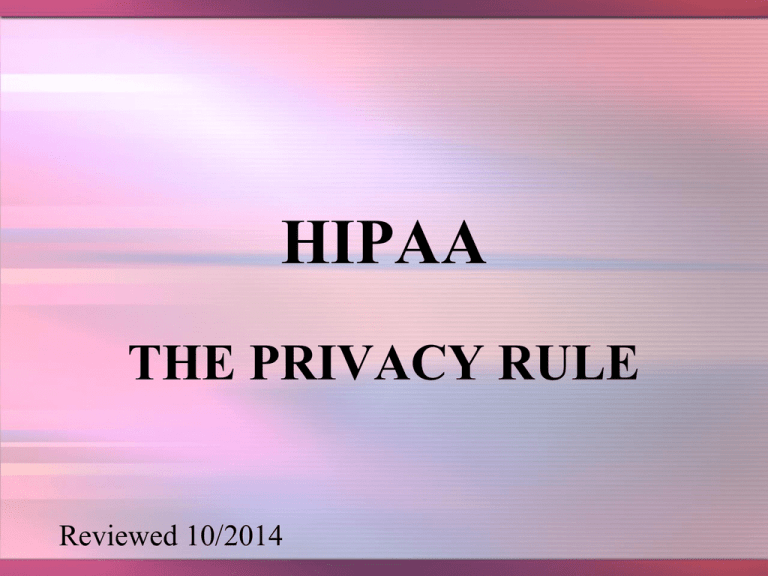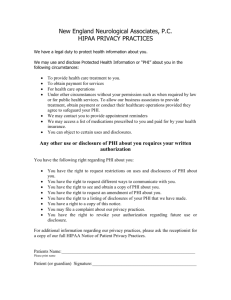HIPAA THE PRIVACY RULE Reviewed 10/2014
advertisement

HIPAA THE PRIVACY RULE Reviewed 10/2014 HISTORY • In 2000, many patients that were newly diagnosed with depression received free samples of antidepressant medications in their mail. 2 HISTORY • Many of these patients were concerned on how the pharmaceutical companies were notified of their disease. 3 HISTORY • After much investigation, the Physician, the Pharmaceutical company and a well known Pharmacy chain were all indicted on breach of confidentiality charges. 4 HISTORY • This is just one example of why the Federal government needed to step in and assist in protecting patient privacy. 5 Definitions • Privacy – state of being concealed; secret • Confidentiality – containing secret information (medical record) • Authorization – to give permission for; to grant power to • Breach Confidentiality – to break an agreement, to violate a promise 6 HIPAA • Health Insurance Portability and Accountability Act – Much of the patient’s health information is documented in a computerized format. Protecting this information has become vitally important. – The first federal legislation (effective April 14, 2003) that attempts to protect a patient’s right to privacy, and the security and access of personal medical information and usage. 7 HIPAA • Privacy Rule – Imposes restrictions on the use/disclosure of personal health information – Gives patients greater protection of their medical records – Hopefully provides patients with greater peace of mind related to the security of their information 8 Confidentiality • Deals with: – Communication or in- formation given to you without fear of disclosure – Legitimate Need to Know & Informed Consent • Potential breeches of confidentiality can occur 9 Protected Health Information • What is Protected Health Information (PHI)? – When a patient gives personal health information to a healthcare provider, that becomes Protected Health Information (PHI) 10 Protected Health Information PHI Includes: Verbal information Information on paper Recorded information Electronic information (faxes, e-mails) 11 Protected Health Information • Examples of patients information – – – – Patients name or address Social Security or other ID numbers Doctor’s/ Nurse’s personal notes Billing information 12 Rules for the Use & Disclosure of PHI • PHI can be used or disclosed for – Treatment, payment, and healthcare operations – With authorization/agreement from patient – For disclosure to patient 13 Rules for the Use & Disclosure of PHI • You’re required to release PHI – When requested/authorized by the patient (some exceptions apply) – When required by the Department Health and Human Services • Patients can request a list of persons who viewed their PHI, but they too must sign a consent 14 Authorization Guidelines • Patient authorization for release of PHI must be obtained in the following situations: – Use/disclosure of psychotherapy notes – For research purposes – For use/disclosure to third parties for making activities 15 Authorization Guidelines • PHI can be used/disclosed without authorization for the following reasons: To inform appropriate agencies Public health activities related to disease prevention/control 16 Authorization Guidelines • PHI can be used/disclosed without authorization: – To report victims of abuse, neglect or domestic violence – To funeral homes, tissue/organ banks – To avert a serious threat to health/safety 17 Notice of Privacy Practices Patients have the right to adequate notice concerning the use/disclosure of their PHI The Notice of Privacy Practices must contain the patient’s rights and the covered entities’ legal duties Patients are required to sign a statement that they were informed of and understand the privacy practices 18 Minimum Necessary • What are the Minimum Necessary requirements? – Use/disclosure of PHI is limited to the minimum amount of health information required to do the job • It means: – Development of polices/practices on sharing health information 19 Minimum Necessary Identify employees who regularly access PHI. Identify the types of PHI needed and the conditions for access. Grant only that access necessary to perform the job. 20 Protections for Health Information • Important Safeguards – Physical Safeguards • Computer terminals are not placed in public areas – Technical Safeguards • Every associate must keep his/her password confidential – Administrative Safeguards • Policy and procedure for release of patient information 21 The Joint Commission Standards • Patients Rights – The hospital demonstrates respect for the following patient needs: • Confidentiality • Privacy • Security • Resolution of complaints • Records and information are protected against LOSS, destruction, tampering and UNAUTHORIZED ACCESS or use 22 The Joint Commission Standards • Patients Rights – Patients have a right to confidentiality of all information that is provided to the healthcare professional and institution – Health care professionals ensure that patient information is secured at all times and if there are any complaints, those complaints will be resolved in a timely manner. 23 Faxing Guidelines Located in non-public areas. Centralized fax machines: Pick up information immediately DO NOT FAX the following records/results: HIV results Mental Health Narcotic prescriptions Alcohol abuse Substance abuse Child abuse 24 Faxing Guidelines When you fax to outside offices: Check the transmission print out Verify that the correct number was dialed 25 Privacy • No photographs or recordings of any type are to be taken of patients in the clinical setting. • No cameras, palm pilots, cell phones or any electronic devices with photography capabilities are permitted in the clinical environment. Protect Your Patient! 26 Enforcement of the Medical Privacy Regulations Office for Civil Rights -A patient may complain to the Privacy Officer in a hospital … OR -The Director of Health and Human Services (HHS) 27 Patient Privacy Rights • It’s your job to make sure patients know they have the right to: – To see and copy their PHI – Protect patient’s privacy and confidentiality – Contact your hospital’s privacy administrator for any privacy concerns 28 HITECH Health Information Technology for Economic and Clinical Health Act HITECH , It’s a Federal Law, part of the American Reinvestment and Recovery Act (ARRA) Effective September 23, 2009 Updated the HIPAA rule to include protections against identity theft HITECH (continued) Purpose: Criminal Penalties Applies to covered health care entities and business associates. Makes massive changes to privacy and security laws •Criminal provisions Creates a nationwide electronic health record •Sharing of civil monetary penalties with harmed individuals Increases penalties for privacy and security violations Breach Notification requirements (Patient, Department of Health and Human Services, and Media) •Penalties What can you do? • If you have any questions, ask your clinical instructor or contact the hospital’s Privacy Administrator 31






